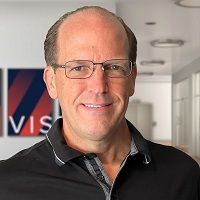Home > Columns > Executive Interviews
Vistio Executive Interview

Gregg Antenen, co-founder and Executive Director, Vistio
Click image below to read the ebook

Gregg Antenen, co-founder and Executive Director of Vistio,
discusses their unique approach to call center optimization with Sheri
Greenhaus, Managing Partner of CrmXchange. Antenen highlights their focus on
enhancing agent experience and shares how their innovative tools, ServiceSim
and AgentHub, are making a significant impact on reducing attrition rates and
improving call center operations. Their solutions are designed to maximize the
value of every agent, whether they’re in training or they are seasoned
professionals.
Sheri Greenhaus: Let's begin with an overarching view of the
company.
Gregg Antenen: Our journey spans a remarkable 25 years.
Throughout my career, I've been fortunate to partner with a colleague, and
together, we've orchestrated the development of four startups. Our modus
operandi has always been centered around identifying a need in the market,
building companies to fulfill that need, and subsequently attracting potential
buyers.
Our initial foray into the world of innovation revolved
around decisions automation. We melded scoring algorithms with unique datasets,
which were immediately accessible. This journey commenced with TransUnion, a
credit bureau with copious data resources. The challenge lies in making this
data available for swift decision-making. Hence, we embarked on the path of
decision automation and instant decisions, leveraging these data sets to
enhance the speed and quality of decision-making.
Our first venture in this domain targeted the property and
casualty insurance sector, revolutionizing underwriting decisions. This success
led us to our second startup, where we harnessed similar capabilities but in a
different context. Here, we integrated these capabilities to streamline
decision automation, specifically focusing on life and health insurance and
risk assessment within the health insurance industry. Our efforts primarily
revolved around back-office data integration.
Building upon this foundation, we extended these concepts
into call centers approximately 16 years ago. Our focus shifted to interactions
between agents and customers, particularly those seeking to purchase or modify
products. Our expertise extended to conducting comprehensive health risk
assessments, using interview techniques and conversation methodologies,
followed by decision-making based on the acquired information. This transition
was pivotal, especially during the shift from traditional underwriting to the
era of Obamacare, where understanding individual risk became imperative.
We were pioneers in this field, having doctors and nurses
manning the phones as early as 2009. Following a series of acquisitions in
2016-17, we realized that the complex interview techniques we employed in
health insurance were like the challenges faced by customer care representatives
across various industries. We recognized that agents, regardless of the sector
they served, required augmentation with tools and processes to excel in their
roles.
This realization marked the inception of Vistio in 2018,
with our initial success story in the utility industry. Our primary objective
was to assist agents in navigating intricate transactions, often involving new
service setups and compliance adherence. This approach, which we had perfected
in the realms of health insurance and utilities, proved invaluable in training
agents to tackle a myriad of customer inquiries and challenges. Our unique
capability enabled us to guide agents comprehensively, from the moment they
answered a call until they concluded their post-call activities, automating as
much of the process as possible.
Sheri Greenhaus: Let's delve deeper into this
transformation. With the emergence of Large Language Models (LLMs) many
organizations are leveraging automation to assist their agents. What is your
approach?
Gregg Antenen: What we've observed is that the low-hanging
fruit, the easy tasks, are already being handled through websites or chatbots.
What this essentially means is that agents are left with the
truly complex problems to solve. In this context, our guidance becomes even
more crucial. So, instead of automating the agent away, we've turned the tables
by using LLMs to simulate customer interactions, effectively making the LLM the
"customer." This approach allows agents to practice and improve their
skills.
What we've recently discovered is that there's a significant
gap between what companies need to train their agents effectively and the
methods they currently employ. Often, traditional training involves presenting
a lot of information and then having agents conduct one or two mock calls. This
approach doesn't provide agents with ample practice, and they're bound to make
mistakes when they finally engage with real customers. Our solution is to offer
agents extensive practice across various call scenarios by simulating customer
interactions. This approach is reshaping the entire structure of agent
training.
Sheri Greenhaus: So, it's not just about training; it's also
about simulation and agent guidance.
Gregg Antenen: Absolutely. Agent guidance has always been at
the core of our approach. When we decided to incorporate AI into our solution,
the question was how to utilize it effectively. While it's possible to automate
calls with chatbots, there are limitations with large language models. They can
make errors, go off-topic, or lack an understanding of a company's internal
processes. However, what large language models excel at is simulating customer
behavior by asking questions and seeking information.
Sheri Greenhaus: Does one aspect of your product seamlessly
complement the other? Are you essentially building the guide while creating the
training system? Does the system learn and adapt based on agent interactions?
Gregg Antenen: You've hit the nail on the head. Our training
and guidance systems are intricately linked. As agents progress through their
training, they encounter various scenarios they may encounter in real calls.
This exposure helps them become more comfortable and familiar with what they
might face when they're on the phone with actual customers. The guide becomes
second nature to them because they've already encountered similar situations
during their training.
Sheri Greenhaus: It sounds like your ServiceSim plays a
pivotal role in getting companies to fine-tune their processes. Does it help
identify areas where agents might need more training?
Gregg Antenen: Indeed, ServiceSim is instrumental in
refining processes. Often, companies believe they have their processes down,
but when we delve into the details of how they want interactions to unfold and
handle various scenarios, they may realize there are gaps in their
understanding. ServiceSim allows agents to practice based on their knowledge
base, and we track the interactions they have with the simulator. We then
summarize these interactions for the company, highlighting areas where agents
may need more training. It's an eye-opener for many organizations.
Sheri Greenhaus: When it comes to the agents themselves, do
you find that your customers are working with top-tier agents, or does your
system help develop them over time?
Gregg Antenen: Our system caters to a range of agents, from
those in training to seasoned professionals. In the training phase, we take
agents through various modules, gradually introducing them to different
scenarios. They start with soft skills like empathy and progressively add
complexities, such as handling billing inquiries. This progressive learning
setup is quick and efficient. We can set up companies with hundreds of call
scenarios in just a few days, allowing them to train on these scenarios
rapidly. The key is ensuring that every step of the process is well-documented,
which often requires a deep dive into the company's specific needs and
processes.
Sheri Greenhaus: It's clear that your approach is all about
understanding the unique needs of each organization and tailoring your solution
accordingly. Can companies make adjustments
themselves if something changes, or is it more efficient for you to handle
these changes?
Gregg Antenen: While companies could make
adjustments themselves, it's usually more efficient for us to handle them.
Our team is well-versed in the intricacies of our system, and we can swiftly
implement any necessary changes. Companies can focus on their core operations,
and we take care of the configuration. In emergencies, we can make changes
almost instantly. In the five years we've been doing this, we haven't
encountered any issues with this approach.
Sheri Greenhaus: Are all these adjustments included in the
licensing fee?
Gregg Antenen: Yes, indeed. Our goal is to make our clients
as efficient as possible, and we intentionally designed our pricing model to
ensure they can use the software to its fullest extent without worrying about
additional costs. We've been on the receiving end of hefty hourly fees for software
changes in the past, and we want to avoid putting our clients in that position.
Sheri Greenhaus: It seems like there are many companies
entering this space. Why do you think that's happening, and how do you
distinguish yourselves from the competition?
Gregg Antenen: The rise in companies entering this space can
be attributed to the increasing use of call recording, which allows
organizations to analyze call data and workflows. However, the real challenge
lies in effectively converting the insights gained from large language models
into actionable solutions within call centers.
Many companies are attempting to address this challenge.
Still, what sets us apart is our comprehensive approach. We start from the
moment an agent answers a call, automating steps and enhancing the agent's
abilities, rather than merely providing instructions. Our aim is to augment
agents, not replace them, by leveraging data, AI, and automation to create a
seamless and efficient process.
Sheri Greenhaus: It's clear that you prioritize
understanding your clients' problems and tailoring solutions to address their
specific needs. Can you share an example of a company that experienced
significant positive changes after working with you?
Gregg Antenen: Certainly, one industry that comes to mind is
the health exchange sector. These exchanges face an array of processing issues
and complex interactions with consumers, often compounded by evolving
regulations and product changes. Our approach has allowed them to navigate
these challenges more effectively. We've worked with various state-level
exchanges, each with its unique problems, and our capabilities have helped them
adapt and improve their operations. These exchanges constantly deal with
"fires" caused by regulatory changes, and our solution has become an
invaluable asset in managing and evolving their processes.
Sheri Greenhaus: It sounds like your approach has made a
significant impact on organizations facing complex and ever-changing
environments. Is there anything else you'd like to share before we conclude?
Gregg Antenen: I'm truly excited about the rapidly evolving
landscape of this industry. We're on the cusp of discovering new ways to leverage
technology and innovation. With AgentHub we focus on experimentation and
finding novel solutions. We aim to simplify complex processes for our clients
and change the way they approach training and agent experience. One key focus
is on reducing attrition rates by improving the overall experience of agents. ServiceSim
has been a significant step forward in achieving this goal.
Sheri Greenhaus: It's evident that you're at the forefront
of driving positive change in the industry. Thank you for sharing your
insights, Gregg. Your innovative approach to agent augmentation and
problem-solving is inspiring. We look forward to seeing how Vistio continues to
shape the future of call center operations.